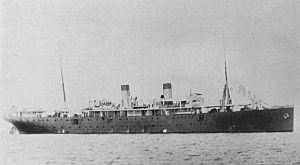Scuttling of SMS Cormoran facts for kids
Quick facts for kids Scuttling of SMS Cormoran |
|||||||
|---|---|---|---|---|---|---|---|
| Part of the Asian and Pacific theatre of World War I | |||||||
 SMS Cormoran |
|||||||
|
|||||||
| Belligerents | |||||||
| Commanders and leaders | |||||||
| Roy Campbell Smith | |||||||
| Strength | |||||||
| Land: 3 artillery pieces 1 artillery battery Sea: 1 auxiliary cruiser |
1 auxiliary cruiser | ||||||
| Casualties and losses | |||||||
| none | 9 killed 1 auxiliary cruiser scuttled |
||||||
The Scuttling of SMS Cormoran happened near Guam on April 7, 1917. This event took place when the United States joined World War I. It involved a German ship called SMS Cormoran that had been staying in Guam.
"Scuttling" means sinking your own ship on purpose. This incident was the only time American and German military forces directly faced each other in the Pacific Ocean during the war.
Contents
The Ship's Story: SMS Cormoran
From Cargo Ship to Raider
The SMS Cormoran started as a passenger and cargo ship. It was built in 1909 by Germans for Russia. Its first name was SS Ryaezan.
When World War I began, a German warship captured it near Korea. The Ryaezan was then turned into an auxiliary cruiser. This means it was a regular ship made into a warship.
The Cormoran was armed with eight powerful guns. Captain Adalbert Zuckschwerdt was in charge of the ship. On August 10, 1914, it left Qingdao to hunt enemy ships in the South Pacific. However, it spent most of its time avoiding Allied warships and did not sink any enemy ships.
Staying in Guam
On December 14, 1914, Captain Zuckschwerdt sailed into Apra Harbor, Guam. He wanted to get coal for his ship from the Americans there. At this time, the United States was a neutral country. This meant they were not taking sides in the war.
Because the U.S. was neutral, they could not give the Germans enough coal to leave. There was also not much coal on the island for anyone. So, the German sailors had to stay in Guam. For about two years, they lived peacefully with the Americans and the people of Guam.
The Scuttling Event
War Is Declared
Everything changed on April 7, 1917. The United States officially joined World War I. This meant the U.S. was now at war with Germany.
American Marines and sailors on Guam quickly got ready. They boarded an old ship called USS Supply. Their mission was to capture the German ship Cormoran or destroy it.
The Americans did not want to hurt the Germans they had lived with. They also wanted to protect the people of Guam. So, they first asked the Germans to give up peacefully.
The Warning Shot
American forces also aimed three large guns from Mount Tenjo at the Cormoran. This was just in case things went wrong. Before Captain Zuckschwerdt could answer, sailors on USS Supply saw something. The Germans were getting ready to sink their own ship! They were not going to surrender or try to escape.
One American sailor fired a rifle shot across the front of the German ship. This was a warning. It was the first shot fired by the United States at the Germans after the war began. A similar event happened in 1915 in the Caribbean.
The Ship Sinks
Even with the warning shot, the Germans kept going. They worked faster to sink their ship. They set off explosives and started to leave the Cormoran. The ship then exploded and quickly sank to the bottom of the harbor. It is still there today.
The USS Supply quickly became a hospital ship. It helped the German sailors who were in lifeboats.
After the Scuttling
Stories about the event are a little different. But we know that nine German sailors died while sinking the Cormoran. They might have died from the explosion or from American fire.
The rest of the German crew were captured by the Americans. The dead sailors were buried on Guam with military honors. The captured Germans were sent to different American forts. They were finally set free in 1919, after World War I ended.
The Shipwreck Today
The SMS Cormoran rests about 110 feet (34 meters) underwater in Apra Harbor. It lies on its left side. A Japanese cargo ship, the Tokai Maru, sank during World War II. It leans against the Cormoran's propeller.
Together, these two ships are a special place for divers. You can see a World War I ship right next to a World War II ship. Because of its link to World War I, the shipwreck was added to the National Register of Historic Places in 1975.


